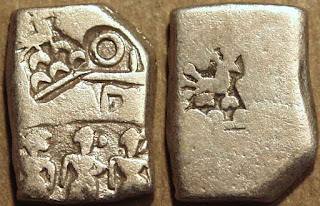Indo-Scythian
Kingdom, Azes I, Silver tetradrachm, c. 1st century BCE
Indo-Scythian Kingdom, Azes I, Silver tetradrachm, c. 1st
century BCE
Weight: 9.52 gm., Diam: 26 mm.
King mounted on horse right, holding spear, Greek legend
around:
BAΣIΛEΩΣ
BAΣIΛEΩN MEΓAΛOY // AZOY
Zeus standing facing, holding thunderbolt and spear,
Kharoshthi legend around:Maharajasa
rajarajasa mahatasa // Ayasa In the north-west, the Indo-Greek kingdom was also crumbling
in the face of a powerful new military presence: the Indo-Scythians. These were
tribes that had entered India from a nomadic existence in Central Asia. One of
the earliest forays of Scythians seems to have occurred around 150 BCE, when
they laid waste to the northern Greek city of Ai-Khanoum (in the northern part
of modern Afghanistan). They seem to have slowly given up their nomadic ways
and began to challenge the Indo-Greeks for supremacy in the area. There is also
some evidence that they intermarried with Indo-Greek royalty.
The greatest expansion of the Indo-Scythian realm was made
by Azes I. Coin 10 is a silver tetradrachm of this ruler, issued probably in
the middle of the 1st century BCE. The overall design of the coin clearly
borrows from the standard Indo-Greek types. There is a portrait of the king on
the obverse, circled by a Greek legend, and there is a chosen deity on the
reverse, circled by a Kharoshthi legend. What is different, however, is that
the king's portrait is not a bust, but rather a representation of the king
mounted on a horse, dressed in full armor, carrying a spear. The horse must
have been an important and potent symbol for a nomadic people and this
equestrian portrait recalls the past, even though the Scythians were now living
a settled life. The deity on the reverse is Zeus, holding a large fulmen (or
thunderbolt) in his right hand and a scepter in his left; it is interesting
that the Scythian nomads quickly adopted the worship of Greek gods.






